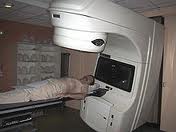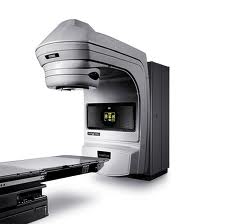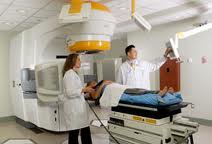Radiosurgery (Radiation Therapy) in India
Introduction:
 Radiosurgery is a specialized form of non-invasive treatment or medical procedure that allows precise delivery of highly focused beam of ionizing radiations to a target lesion. The target lesion is treated with similar precision as a surgeon would in a surgery, and radiosurgery can treat lesions without significant damages to the surrounding tissues, arteries and veins. It is also known as stereotactic radiotherapy (SRT) when used to target lesions in the brain, and stereotactic body radiotherapy (SBRT) when used to target lesions in the body.
Radiosurgery is a specialized form of non-invasive treatment or medical procedure that allows precise delivery of highly focused beam of ionizing radiations to a target lesion. The target lesion is treated with similar precision as a surgeon would in a surgery, and radiosurgery can treat lesions without significant damages to the surrounding tissues, arteries and veins. It is also known as stereotactic radiotherapy (SRT) when used to target lesions in the brain, and stereotactic body radiotherapy (SBRT) when used to target lesions in the body.
Radiosurgery is traditionally used for tumors or vascular lesions in the brain. Radiosurgery has been particularly effective in the treatment of benign brain and skull-base tumors as well as vascular lesions in the brain. Advancement in radiosurgery technology has resulted in enormous expansion of treatment indications for this procedure. They include benign or malignant brain tumors, benign or malignant spine tumors, vascular malformations, trigeminal neuralgia, tremors, and movement disorders. Although radiosurgery was first designed for diseases in the brain, new developments in frameless systems now allow treatment of lesions from head to toe.
How does Radiosurgery work?
Radiosurgery works in the same manner as other types of therapeutic radiology: it distorts or destroys the DNA of tumor cells, causing them to be unable to reproduce and grow. The tumor will shrink in size over time. For blood vessel lesions such as an arteriovenous malformation (AVM), the blood vessels eventually close off after treatment.
Radiosurgery Treatment Techniques:
 Different radiosurgery techniques exist, and some radiosurgery techniques require placement of a frame, whereas other techniques can be performed frameless. Frame-based techniques are typically use for brain and skull-base lesions and they may offer higher accuracy. Frameless based radiosurgery are performed with better patient comfort and can be used for lesions throughout the body. Stereotactic radiosurgery generally uses gamma rays or x-rays. There is also increasing interest in using particle therapy such as protons and carbon for radiosurgery.
Different radiosurgery techniques exist, and some radiosurgery techniques require placement of a frame, whereas other techniques can be performed frameless. Frame-based techniques are typically use for brain and skull-base lesions and they may offer higher accuracy. Frameless based radiosurgery are performed with better patient comfort and can be used for lesions throughout the body. Stereotactic radiosurgery generally uses gamma rays or x-rays. There is also increasing interest in using particle therapy such as protons and carbon for radiosurgery.
There are three types of radiosurgery. Each type uses different equipment and radiation sources. Radiosurgery types include :
- Cobalt60 systems (Gamma Knife)
- Linear Accelerator (LINAC) Systems
- Proton Beam Therapy
Cobalt60 systems (Gamma Knife)
Introduction:The Gamma Knife is not really a knife. It uses beams of highly-focused gamma rays to treat small- to medium-size lesions, usually in the brain. Gamma Knife consists of radioactive sources of Cobalt-60 placed in a helmet with central channels for irradiation. In the latest version of this device, 192 sources of radioactive cobalt direct gamma radiation to the center of a helmet, where the patient's head is inserted. This is called the Leksell Gamma Knife Perfexion. During Gamma Knife treatment, the equipment remains stationary (does not move).
Benefits of Gamma Knife:The Gamma Knife is used primarily to treat small and medium lesions in and around the brain.
- Brain tumors : Meningiomas, Acoustic neuromas, Pituitary tumors, Gliomas Craniopharyngiomas, Brain tumor metastases
- Other conditions : Arteriovenous malformations, Dural arteriovenous fistulas, Cavernous malformations, Trigeminal neuralgia
Gamma Knife treatment generally involves these steps:
- Head Frame Placement : In order to keep the head from moving during treatment, a box-shaped frame is attached to the head. Pins designed specifically for this purpose fasten the head frame to the skull. The head frame also is a guide to focus the gamma ray beams to the exact location of the lesion being treated.
- Tumor Location Imaging : Once the head frame is in place, the exact location of the lesion to be treated will be determined using computed tomography (CT scan) or magnetic resonance imaging (MRI).
- Radiation Dose Planning : After the CT or MRI scan has been completed, the radiation therapy team will determine the treatment plan. The results of the imaging scan, along with other information, will be used by a medical physicist to determine the best treatment.
- Radiation Treatment : After being positioned for the treatment, a type of helmet with many hundreds of holes in it is placed over the head frame. These holes help to focus the radiation beams on the target. Treatment will last a few minutes up to a few hours, depending on the type and location of the area being treated. Generally, only one treatment session is required for a lesion.
Linear Accelerator (LINAC) Systems
Introduction: LINAC or Linear accelerator machines produce radiation that is referred to as high-energy x-ray. A linear accelerator machine is designed to be a general purpose radiation delivery machine and requires modifications to enable it to be used for radiosurgery and so for treating tumours.
LINAC or Linear accelerator machines produce radiation that is referred to as high-energy x-ray. A linear accelerator machine is designed to be a general purpose radiation delivery machine and requires modifications to enable it to be used for radiosurgery and so for treating tumours.Some common types of LINAC systems include CyberKnife, X-Knife, Novalis, and Peacock. In addition to not using radioactive material to produce the radiation, LINAC systems also differ from the Gamma Knife in that the machinery moves around the patient during treatment and can access larger affected areas. LINAC technology is most often used in multi-session treatments in order to avoid damaging healthy surrounding tissue with too high a dose of radiation.
Benefits of Linear Accelerator (LINAC) System:The best usage of LINAC technology may be its ability to target larger brain and body cancers with less damage to healthy tissues. LINAC systems are able to treat larger tumors and larger affected areas than the Gamma Knife. Areas other than the brain can be treated with a LINAC system. Linear accelerator systems may also be used for external beam radiation therapy.
Steps Involved:Treatment steps with a LINAC system are generally the same or similar to the treatment steps used for the Gamma Knife.
Proton Beam Therapy
Introduction:Proton beam therapy is a type of particle beam radiation therapy. Rather than using rays of radiation, such as gamma rays or x-rays, particle beam therapy uses particles such as protons or neutrons. Proton beam therapy is not widely available. The radiation dose can be more closely controlled with these systems, because the proton beam can be controlled to allow it to deposit its energy almost completely in the tumor or lesion being treated. Other forms of radiation lose energy as they enter body tissues on their way to the tissue under treatment.
Benefits of Proton Beam Therapy:Proton beam therapy is useful in treating tumors or lesions that are small and/or have an irregular shape. Because the depth of the proton beam can be controlled so precisely, less damage occurs to normal tissues surrounding the area under treatment. Proton beam therapy may be used for radiosurgery procedures or for fractionated radiotherapy (several smaller doses of radiation over a certain period of time).
Phone Numbers Reach Us-
India & International : +91-9860755000 / +91-9371136499
UK : +44-2081332571
Canada & USA : +1-4155992537
Benefits of Radiosurgery:
 Radiosurgery Benefits India Radiosurgery is an effective treatment of various diseases. Patients can be treated without incurring incisions or surgical trauma i.e; treated invasively. The procedure is performed on an outpatient basis or with less than 24 hour observation. Radiosurgery is an effective treatment for many benign and malignant tumors, and it delivers highly precise and lethal doses to the tumor cells or lesions without significantly damaging healthy tissues, nearby arteries and veins, critical structures such as the brain stem, nerves and eyes. In addition, many cancers that were once thought as radiation resistant are now effectively treated with radiosurgery. Irregular shape tumours can also be treated with the help of radio surgery. Radiosurgery is a technology used to treat a variety of soft tissue conditions, from the skin to deeper tissues.
Radiosurgery Benefits India Radiosurgery is an effective treatment of various diseases. Patients can be treated without incurring incisions or surgical trauma i.e; treated invasively. The procedure is performed on an outpatient basis or with less than 24 hour observation. Radiosurgery is an effective treatment for many benign and malignant tumors, and it delivers highly precise and lethal doses to the tumor cells or lesions without significantly damaging healthy tissues, nearby arteries and veins, critical structures such as the brain stem, nerves and eyes. In addition, many cancers that were once thought as radiation resistant are now effectively treated with radiosurgery. Irregular shape tumours can also be treated with the help of radio surgery. Radiosurgery is a technology used to treat a variety of soft tissue conditions, from the skin to deeper tissues.
Side Effects:
Patient have a dose of steroids after the treatment to help prevent swelling of the brain and may feel a bit sick, faint or dizzy after the treatment, or have a headache. It is usual to feel very tired for some days after the treatment. Over time, a few people develop some dead cells in the treated area. This is called radiation necrosis. For most people it causes no symptoms. A few people need to take steroids to treat the swelling it can cause, and a small number will need surgery to remove the dead cells.
Radiosurgery in India:
India has assembled a specialized team of oncologists and neurosurgeons that are able to treat not only patients needing conventional radiotherapy, but most importantly brain tumors with stereotactic radiosurgery. As an emerging medical travel destination, India offers more interesting healthcare specialties with its accredited hospitals, army of US-trained doctors, radiation oncology associates and physicians. Not only Indian hospitals have the top oncologists teamed together to form cancer-specialized centers, but also the equipment they manage is increasingly sophisticated. Most of the latest oncology products including linear accelerators are available in these hospitals . Professionals who handle radiotherapy and radiosurgery in these hospitals are skilled and experienced. Indian hospitals have raised bar for cancer treatments by pioneering revolutionary advances such as proton therapy, image- guide radiotherapy etc at an extremely cost-effective price and with complete quality assurance.
Cities in India that offers Radiosurgery (radio-therapy) facilities are as follows :
| Mumbai | Hyderabad | Kerala |
| Delhi | Pune | Goa |
| Bangalore | Nagpur | Jaipur |
| Chennai | Gurgaon | Chandigarh |
Patient from Kenya – Ms. Marilyn Mwangi shares her experience of Radiosurgery Radiation Therapy in India

Ms. Marilyn Mwangi from Kenya
Brain is a very complicated part of the body to treat upon. In fact, there are some regions in the brain which are not possible to be reached through an open surgery and thus require the modern radiation tools to perform the radiosurgery therapy. The doctors at Dheeraj Bojwani Group have access to all the machines and tools along with possessing the experience to perform such technical and risky surgeries in the parts of the brains to remove the tumor. You can trust them with your life literally and be assured that they will do everything possible to ensure that you become healthy again.
★★★★★ Published
Low-Cost Radiosurgery in India:
 Low Cost RadiosurgeryIndia provides the most advanced and versatile radiation therapies that help treat cancer and other diseases at a highly competitive price. It offers patients the most advanced cancer care in a supportive setting and a variety of individualized treatment options at an economical cost. This has made India a hot destination for radiosurgery and radiotherapy. India is pulling radiosurgery seekers from all across the globe. In India not only the medical treatment is extremely reasonable but also the travel and accomodation cost is attractively cheaper. The top notch hospitals are extremely competitive not only in price but also in quality. The total cost of complete treatment including hotel stay and travel, if compared with the total cost incurred for the similar treatment in US or UK, the difference is quiet astonishing, as In India one can save around 70-80%.
Low Cost RadiosurgeryIndia provides the most advanced and versatile radiation therapies that help treat cancer and other diseases at a highly competitive price. It offers patients the most advanced cancer care in a supportive setting and a variety of individualized treatment options at an economical cost. This has made India a hot destination for radiosurgery and radiotherapy. India is pulling radiosurgery seekers from all across the globe. In India not only the medical treatment is extremely reasonable but also the travel and accomodation cost is attractively cheaper. The top notch hospitals are extremely competitive not only in price but also in quality. The total cost of complete treatment including hotel stay and travel, if compared with the total cost incurred for the similar treatment in US or UK, the difference is quiet astonishing, as In India one can save around 70-80%.
Phone Numbers Reach Us-
India & International : +91-9860755000 / +91-9371136499
UK : +44-2081332571
Canada & USA : +1-4155992537
Some of the common countries from which patients travel to India for surgery are:
| USA | UK | Canada |
| Australia | New Zealand | Nigeria |
| Kenya | Ethiopia | Uganda |
| Tanzania | Zambia | Congo |
| Sri Lanka | Bangladesh | Pakistan |
| Afghanistan | Nepal | Uzbekistan |
Below are the downloadable links that will help you to plan your medical trip to India in a more organized and better way. Attached word and pdf files gives information that will help you to know India more and make your trip to India easy and memorable one.
| Click icon to Download Document | ||||||
| About India | Destinations in India | |||||
| Indian Embassy List | Medical Tourism FAQ | |||||
| Visa For India | ||||||
 Apollo Hospital
Apollo Hospital Fortis Hospital
Fortis Hospital Artemis Hospital
Artemis Hospital Max Hospital
Max Hospital Columbia Asia Hospital
Columbia Asia Hospital Medanta Hospital
Medanta Hospital


 Jaslok Hospital
Jaslok Hospital Lilavati Hospital
Lilavati Hospital


 Global Hospitals
Global Hospitals